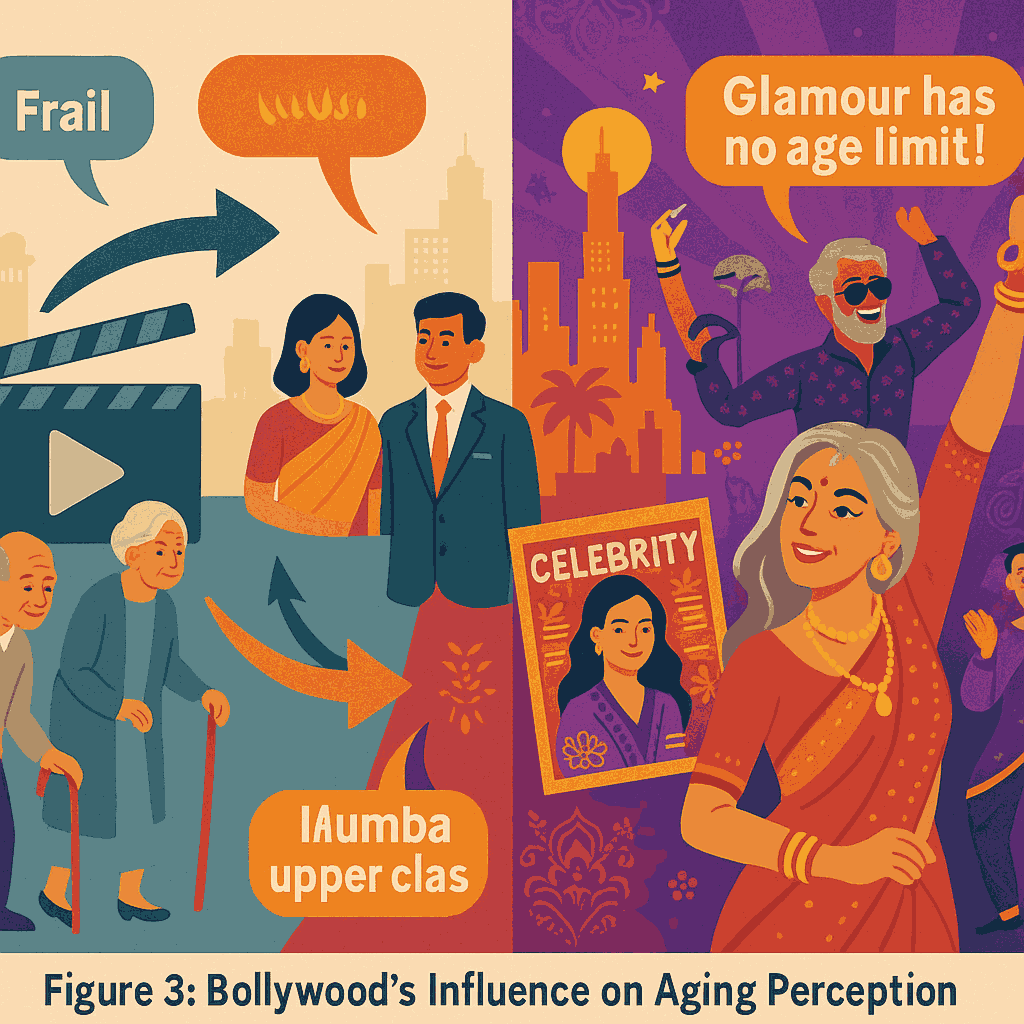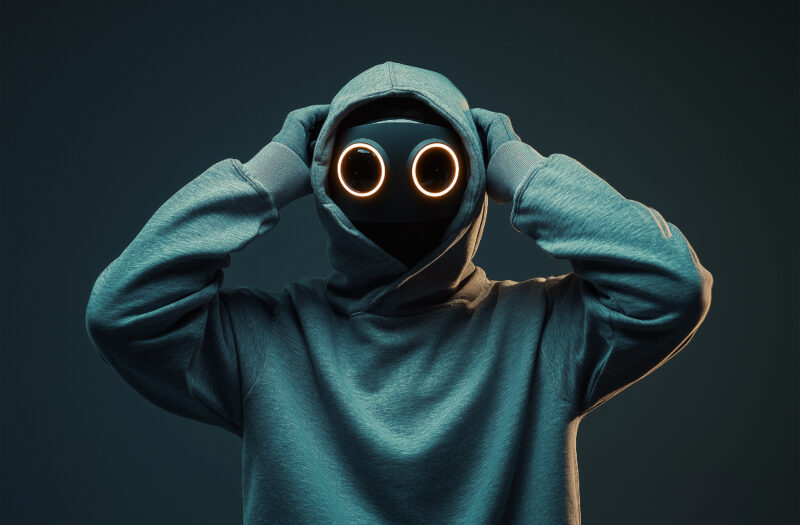Keywords: Ageing, Bollywood, Media Literacy, Urban Upper Economic Class
Abstract
Mumbai's urban upper economic class faces unique pressures to maintain youthfulness, shaped by pervasive societal norms and the influential portrayals of ageing in Bollywood media. This study aims to evaluate how Bollywood's representations impact perceptions of ageing among Mumbai's affluent, and to explore the implications for media literacy and educational strategies. Employing a quantitative survey approach, data were collected from 32 upper-class residents of Mumbai using Google Forms and analyzed with SPSS to assess attitudes toward ageing, the influence of media, and gendered expectations. The findings reveal that Bollywood's youth-centric narratives significantly contribute to negative perceptions of ageing, reinforcing ageist stereotypes and intensifying the desire to appear youthful, with notable differences between male and female respondents. These results underscore the urgent need for inclusive and diverse media representations, as well as the integration of media literacy interventions in educational and community settings to foster critical engagement with age-related stereotypes. The study concludes that promoting media literacy and age-inclusive content can play a pivotal role in challenging societal biases, supporting intergenerational understanding, and informing policy and curriculum development in urban India.
References
Aljohani, N. F., & Jaha, E. S. (2023). Visual Lip-Reading for Quranic Arabic Alphabets and Words Using Deep Learning. Computer Systems Science and Engineering, 46(3), 3037–3058. https://doi.org/10.32604/csse.2023.037113 DOI: https://doi.org/10.32604/csse.2023.037113
Bai, Z., Li, Z., Li, Z., Song, Y., Gao, Q., & Mao, Z. (2023). Domain-Adaptive Emotion Recognition Based on Horizontal Vertical Flow Representation of EEG Signals. IEEE Access, 11, 55023–55034. https://doi.org/10.1109/ACCESS.2023.3270977 DOI: https://doi.org/10.1109/ACCESS.2023.3270977
Benhafid, Z., Selouani, S. A., Amrouche, A., & Sidi Yakoub, M. (2025). Attentive Context-Aware Deep Speaker Representations for Voice Biometrics in Adverse Conditions. Circuits, Systems, and Signal Processing, 44(1), 534–555. https://doi.org/10.1007/s00034-024-02854-4 DOI: https://doi.org/10.1007/s00034-024-02854-4
Chakhtouna, A., Sekkate, S., & Abdellah, A. (2024). Modeling Speech Emotion Recognition via ImageBind representations. Procedia Computer Science, 236, 428–435. https://doi.org/10.1016/j.procs.2024.05.050 DOI: https://doi.org/10.1016/j.procs.2024.05.050
Cheng, T., Curley, M., & Barmettler, A. (2022). Skin Color Representation in Ophthalmology Textbooks. Medical Science Educator, 32(5), 1143–1147. https://doi.org/10.1007/s40670-022-01636-4 DOI: https://doi.org/10.1007/s40670-022-01636-4
Chernyak, B. R., Bradlow, A. R., Keshet, J., & Goldrick, M. A. (2024). A perceptual similarity space for speech based on self-supervised speech representations. Journal of the Acoustical Society of America, 155(6), 3915–3929. https://doi.org/10.1121/10.0026358 DOI: https://doi.org/10.1121/10.0026358
Cho, S., & Wee, K. (2025). Multi-Noise Representation Learning for Robust Speaker Recognition. IEEE Signal Processing Letters, 32, 681–685. https://doi.org/10.1109/LSP.2025.3530879 DOI: https://doi.org/10.1109/LSP.2025.3530879
Farhana, I., Shin, J., Mahmood, S., Rabiul Islam, M. D., & Molla, M. K. I. (2023). Emotion Recognition Using Narrowband Spatial Features of Electroencephalography. IEEE Access, 11, 44019–44033. https://doi.org/10.1109/ACCESS.2023.3270177 DOI: https://doi.org/10.1109/ACCESS.2023.3270177
Fu, K., Du, C., Wang, S., & He, H. (2024). Improved Video Emotion Recognition With Alignment of CNN and Human Brain Representations. IEEE Transactions on Affective Computing, 15(3), 1026–1040. https://doi.org/10.1109/TAFFC.2023.3316173 DOI: https://doi.org/10.1109/TAFFC.2023.3316173
Gharib, S., Tran, M., Luong, D., Drossos, K., & Virtanen, T. (2024). Adversarial Representation Learning for Robust Privacy Preservation in Audio. IEEE Open Journal of Signal Processing, 5, 294–302. https://doi.org/10.1109/OJSP.2023.3349113 DOI: https://doi.org/10.1109/OJSP.2023.3349113
He, S., Xue, W., Yang, Y., Zhang, H., Pan, J., & Zhang, X. (2025). Enhancing target speaker extraction with Hierarchical Speaker Representation Learning. Neural Networks, 188. https://doi.org/10.1016/j.neunet.2025.107388 DOI: https://doi.org/10.1016/j.neunet.2025.107388
Hu, Y., Chen, C., Zhu, Q., & Chng, E. (2024). Wav2code: Restore Clean Speech Representations via Codebook Lookup for Noise-Robust ASR. IEEE/ACM Transactions on Audio Speech and Language Processing, 32, 1145–1156. https://doi.org/10.1109/TASLP.2023.3332545 DOI: https://doi.org/10.1109/TASLP.2023.3332545
Ichikawa, R., Zhang, B., & Lim, H. (2023). Research on a Guide Dog Robot for Expressing Visual Environment by Voice; 視覚環境を音声で表現可能な盲導犬ロボットに関する研究. IEEJ Transactions on Electronics, Information and Systems, 143(5), 562–568. https://doi.org/10.1541/ieejeiss.143.562 DOI: https://doi.org/10.1541/ieejeiss.143.562
Ishaq, M. H., Khan, M., & Kwon, S. (2023). TC-Net: A Modest & Lightweight Emotion Recognition System Using Temporal Convolution Network. Computer Systems Science and Engineering, 46(3), 3355–3369. https://doi.org/10.32604/csse.2023.037373 DOI: https://doi.org/10.32604/csse.2023.037373
Karjigi, V., Roopa, S., & H․M․, C. M. (2024). Investigation of different time–frequency representations for detection of fricatives. International Journal of Speech Technology, 27(3), 599–611. https://doi.org/10.1007/s10772-024-10129-1 DOI: https://doi.org/10.1007/s10772-024-10129-1
Li, T., Fu, B., Wu, Z., & Liu, Y. (2023). EEG-Based Emotion Recognition Using Spatial-Temporal-Connective Features via Multi-Scale CNN. IEEE Access, 11, 41859–41867. https://doi.org/10.1109/ACCESS.2023.3270317 DOI: https://doi.org/10.1109/ACCESS.2023.3270317
Mai, S., Sun, Y., Zeng, Y., & Hu, H. (2023). Excavating multimodal correlation for representation learning. Information Fusion, 91, 542–555. https://doi.org/10.1016/j.inffus.2022.11.003 DOI: https://doi.org/10.1016/j.inffus.2022.11.003
Mao, K., Wang, Y., Ren, L., Zhang, J., Qiu, J., & Dai, G. (2023). Multi-branch feature learning based speech emotion recognition using SCAR-NET. Connection Science, 35(1). https://doi.org/10.1080/09540091.2023.2189217 DOI: https://doi.org/10.1080/09540091.2023.2189217
Padman, S. N., & Magare, D. B. (2023). Multi-modal speech emotion detection using optimised deep neural network classifier. Computer Methods in Biomechanics and Biomedical Engineering: Imaging and Visualization, 11(5), 2020–2038. https://doi.org/10.1080/21681163.2023.2212082 DOI: https://doi.org/10.1080/21681163.2023.2212082
Prain, V., Xu, L., & Speldewinde, C. A. (2023). Guiding Science and Mathematics Learning when Students Construct Representations. Research in Science Education, 53(2), 445–461. https://doi.org/10.1007/s11165-022-10063-9 DOI: https://doi.org/10.1007/s11165-022-10063-9
Puffay, C., Vanthornhout, J., Gillis, M., Accou, B., Van hamme, H., & Francart, T. (2023). Robust neural tracking of linguistic speech representations using a convolutional neural network. Journal of Neural Engineering, 20(4). https://doi.org/10.1088/1741-2552/acf1ce DOI: https://doi.org/10.1088/1741-2552/acf1ce
Qiu, Y., Tian, H., Li, H., Chang, C. C., & Vasilakos, A. V. (2023). Separable Convolution Network With Dual-Stream Pyramid Enhanced Strategy for Speech Steganalysis. IEEE Transactions on Information Forensics and Security, 18, 2737–2750. https://doi.org/10.1109/TIFS.2023.3269640 DOI: https://doi.org/10.1109/TIFS.2023.3269640
Qu, L., Li, T., Weber, C., Pekarek-Rosin, T., Ren, F., & Wermter, S. (2024). Disentangling Prosody Representations With Unsupervised Speech Reconstruction. IEEE/ACM Transactions on Audio Speech and Language Processing, 32, 39–54. https://doi.org/10.1109/TASLP.2023.3320864 DOI: https://doi.org/10.1109/TASLP.2023.3320864
Salimpour, S., Tytler, R. W., Eriksson, U., & Fitzgerald, M. T. (2021). Cosmos visualized: Development of a qualitative framework for analyzing representations in cosmology education. Physical Review Physics Education Research, 17(1). https://doi.org/10.1103/PhysRevPhysEducRes.17.013104 DOI: https://doi.org/10.1103/PhysRevPhysEducRes.17.013104
Teixeira, F. S., Abad, A., Raj, B., & Trancoso, I. M. (2024). Privacy-Oriented Manipulation of Speaker Representations. IEEE Access, 12, 82949–82971. https://doi.org/10.1109/ACCESS.2024.3409067 DOI: https://doi.org/10.1109/ACCESS.2024.3409067
Wong, K., & Meng, H. M. L. (2023). Automatic Analyses of Dysarthric Speech based on Distinctive Features. APSIPA Transactions on Signal and Information Processing, 12(3). https://doi.org/10.1561/116.00000077 DOI: https://doi.org/10.1561/116.00000077
Xie, Y., Liang, R., Liang, Z., Zhao, X., & Zeng, W. (2023). Speech Emotion Recognition Using Multihead Attention in Both Time and Feature Dimensions. IEICE Transactions on Information and Systems, E106.D(5), 1098–1101. https://doi.org/10.1587/transinf.2022EDL8084 DOI: https://doi.org/10.1587/transinf.2022EDL8084
Xin, R., Miao, F., Cong, P., Zhang, F., Xin, Y., & Feng, X. (2023). Multiview Feature Fusion Attention Convolutional Recurrent Neural Networks for EEG-Based Emotion Recognition. Journal of Sensors, 2023. https://doi.org/10.1155/2023/9281230 DOI: https://doi.org/10.1155/2023/9281230
Xuejun, W. (2023). Application of sensor-based sound control principle in speech recognition technology. International Journal of System Assurance Engineering and Management. https://doi.org/10.1007/s13198-023-01939-8 DOI: https://doi.org/10.1007/s13198-023-01939-8
Yamamoto, K., Zhu, Y., Aoyama, T., Takeuchi, M., & Hasegawa, Y. (2023). Improvement in the Manipulability of Remote Touch Screens Based on Peri-Personal Space Transfer. IEEE Access, 11, 43962–43974. https://doi.org/10.1109/ACCESS.2023.3271003 DOI: https://doi.org/10.1109/ACCESS.2023.3271003
Yuan, K., Srivastav, V., Yu, T., Lavanchy, J. L., Marescaux, J. F., Mascagni, P., Navab, N., & Padoy, N. (2025). Learning multi-modal representations by watching hundreds of surgical video lectures. Medical Image Analysis, 105. https://doi.org/10.1016/j.media.2025.103644 DOI: https://doi.org/10.1016/j.media.2025.103644
Yusuf, B., Cernocký, J. “Honza,” & Saraçlar, M. (2023). End-to-End Open Vocabulary Keyword Search with Multilingual Neural Representations. IEEE/ACM Transactions on Audio Speech and Language Processing, 31, 3070–3080. https://doi.org/10.1109/TASLP.2023.3301239 DOI: https://doi.org/10.1109/TASLP.2023.3301239
Zhang, H., Li, H., Peng, G., Liu, Y., & Xu, D. (2023). Image Emotion Recognition via Fusion Multi-Level Representations; 多层次特征融合表征的图像情感识别. Jisuanji Fuzhu Sheji Yu Tuxingxue Xuebao/Journal of Computer-Aided Design and Computer Graphics, 35(10), 1566–1576. https://doi.org/10.3724/SP.J.1089.2023.19742
Zhou, Y., Wu, Z., Zhang, M., Tian, X., & Li, H. (2023). TTS-Guided Training for Accent Conversion Without Parallel Data. IEEE Signal Processing Letters, 30, 533–537. https://doi.org/10.1109/LSP.2023.3270079 DOI: https://doi.org/10.1109/LSP.2023.3270079
Zhuang, H., Xiao, Y., Liu, Q., Yu, B., Xiong, J., & Bao, L. (2021). Comparison of nature of science representations in five Chinese high school physics textbooks. International Journal of Science Education, 43(11), 1779–1798. https://doi.org/10.1080/09500693.2021.1933647 DOI: https://doi.org/10.1080/09500693.2021.1933647

Published
How to Cite
Issue
Section
License
Copyright (c) 2025 Samikshya Madhukullya, Sandeep Gupta

This work is licensed under a Creative Commons Attribution-ShareAlike 4.0 International License.

 https://doi.org/10.61650/alj.v3i2.694
https://doi.org/10.61650/alj.v3i2.694






 Chat Now
Chat Now
 All publications by the CV. Bimbingan Belajar Assyfa [e-ISSN:
All publications by the CV. Bimbingan Belajar Assyfa [e-ISSN: